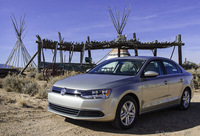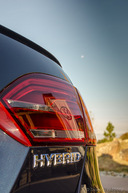2013 Volkswagen Jetta Hybrid Launch Review By Thom
Cannell

2013 Volkswagen Jetta
Hybrid
|
SEE ALSO: Volkswagen Buyers Guide
A different way of thinking, Volkswagen’s 2013 Jetta Hybrid
is built for drivers.
By Thom Cannell
Michigan Bureau
The Auto Channel
Volkswagen’s 2013 Jetta Hybrid rolls Viagra when compared to
the pious brigade of wimpy hybrid appliances masquerading as driver’s
cars. Boasting an all-new turbocharged engine snatched from the latest
European Golf and Audi A3, the Jetta Hybrid is the 1.4-liter motor’s
US debut. Jetta Hybrid is different from others hybrids, alone in combining
a turbocharged direct injected engine, a DSG or direct sequentially shifted
automatic manual transmission, and electric e-motor. This hybrid feels like
a 170hp sport sedan, it’s an eco-friendly, greenly mean pomposity
buster.

|
VW;s new Hybrid is a serial hybrid versus the common power-split or
blended arrangement. For VW this results in some very good things. First it
is sporty in keeping with Brand image (anyone think Prius sells sporty?)
and fastest to 0-60 at a respectable 8.6 seconds. Their design is focused
on high speed efficiency. Established competitors like Honda Civic, the
Prius family, Ford Fusion and C-Max hybrids, Lincoln MKZ Hybrid, and Honda
Insight seem more concerned with city driving. In this crowded niche VW
offers a reasonable pricing structure starting at $24,995 and rising to
$31,980. All are based the well-received Jetta platform with newly uprated
interiors featuring a bit more bright and shiny, new colors, and the entry
models have standard equipment like BlueTooth mobile connection, automatic
climate control, and leather covered multifunction steering wheel. Other
trim levels offer the full list of luxury items like bi-Xenon headlamps
with LEDs, navigation screens, and bombastic audio systems.

|
The core of Jetta Hybrid is a Jetta GLI with its independent rear
suspension, plus the new powertrain. Overall it weights 154 pounds more
than parent GLI including battery, electronics, transmission and e-motor.
There also seems to be more sound deadening and improved window thickness
which drives weight up as it makes the interior quieter. Normally adding
weight means decreased fuel economy but again, the Hybrid gets over 40mpg
with ease under heavy mountain driving. Actually, Jetta Hybrid without its
e-motor would be quite a nice car and is more powerful than the Jetta 2.0
and Jetta TDI and similar to Jetta 2.5 at 170 combined horsepower. You
could use the sport-shift gate of the transmission to shift manually or
raise the shift points on the computer controlled transmission. We
didn’t as our primary goal was to behave as we expect most customers
will, put it in D and go.
In a very important way that is what this story is about, the power
and how little you need to modify your driving style to achieve the economy
Volkswagen’s preliminary estimates promise. We’ve driven all
the hybrids and most require that, to get those exalted economy numbers,
you drive with a mere squirrel cage of power. That technique is similar to
always driving with an egg of questionable freshness between pedal and your
foot: push too hard and the fuel economy egg is all gone.

|
This one is somewhat different. In downtown stop-and-go driving we
kept up with average traffic, cars and pickups, while accelerating under
electric power only. By the way Jetta Hybrid offers two electric modes,
normal which will accelerate to 37 mph and “e”, which can reach
the mid-40s if the battery is fully charged. Like any hybrid the
battery’s charge state is crucial to getting those big returns at the
gas pump. So, with no coaching or coercion you find yourself modifying
driving habits instinctively, reducing both the speed of accelerator
depression and how far you depress. Those are absolutely critical
distinctions!
It doesn’t matter what kind of car you drive, the faster and
deeper you push the accelerator the less economy your vehicle will deliver,
period. It is also how every car so equipped uses its “eco”
mode to modify your driving habits, whether a “shift up” light,
power flow pictogram, or meter. VW has a great three.
Replacing the tachometer is a large dial with green, blue, and white
sections. Green is regeneration, where the vehicle sucks energy out of the
“braking” system and into the battery. In the blue zones (there
are heavy and thin zones) you are driving with great efficiency whether
drawing on battery, gas engine, or a combination. In white, typically
reserved for heavy passing maneuvers, the gas engine is doing the work. At
the far end of the dial a double white zone echoes your full throttle
acceleration. We easily drove in the blue zone without too much
modification of our normal driving styles. We concluded that, depending on
whether we were headed uphill from a stop, we could push the pedal quite
far and quite quickly while accelerating in full electric mode.

|
That’s how you get the big numbers. How big? On the first leg of our
test we showed over 60 “mpg” on the meter. That was mostly
level and downhill from Santa Fe’s 7,000 foot elevation. The next
section with mountainous driving reduced our economy to 44 mpg and we ended
our drive slightly above 42 mpg. Remember, that’s in the mountains
around Santa Fe, New Mexico, not Chicago or Los Angeles. Note that often
the engine will come on just to charge the battery, as it must, so coasting
whenever possible becomes a new norm, one quickly adopted. It's our
observation that you change your driving style less in the VW than other
hybrids and that its 80 pound 1.2-kW lithium ion battery is quickly
recharged.

|
The second power meter is a now-familiar pictogram in the center
console, if you’ve upgraded to the navigation system. It’s
cute, and potentially distracting. However, drill beyond the blue or green
arrows and it will display how much time you’ve spent using IC or
electric power. The best diagram is between the dial and the speedometer.
There a simple flow diagram in non-distracting white clearly displays where
power is flowing. Keeping the “tach” needle in the blue or
observing power flows is a better bet for efficient driving.

|
Jetta Hybrid does not travel completely incognito, thought it does
hide its tail pipe in an ode to ZEV. It provides subtle blue substrates
beneath the badges, a slew of aerodynamic tweaks including underbody trays
and diffusers, a modest spoiler integrated into the trunk lid, and a new
front air dam. All contribute to lowering aerodynamic drag a bit and thus
enhancing fuel economy. Another feature, one gaining multi-brand popularity
is a device that can block all or part of the cooling air passing through
the front grill. Closing to prevent unnecessary air flow lowers drag and
opening improves cooling.

|
All the models, Jetta Hybrid, Hybrid SE and SEL have Bluetooth
mobile phone connection, a leather wrapped steering wheel and automatic
climate control—cool cabin air helps to cool the battery. The base
model includes a six-speaker audio system while the SE which we drove,
added an upscale radio with power distribution display, satellite radio,
plus keyless entry and LED tail lamps. You can upgrade the audio system to
a navigation system and add a power tilt-slide sunroof with an SEL, or go
full bore with a Jetta Hybrid SEL Premium with exclusive Fender audio
system, LED daylight running lights, active (self-pointing) bi-Xenon
headlights, plus fog lamps and cornering lights.
Overall there is something simple about this hybrid, an attempt to
make its frugality appealing and transparent. The engine system is simple
and efficient, the battery small and light, its all-electric range only a
mile or so. That’s enough to offer many drivers a reasonable payback
period on the price difference between Jetta and Jetta Hybrid (VW says
it’s similar to the TDI diesel, $1,000+) if you either want an
eco-friendly automobile or your driving is mixed.










